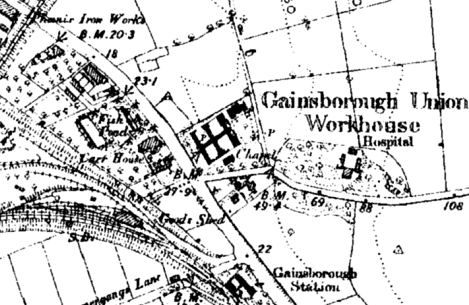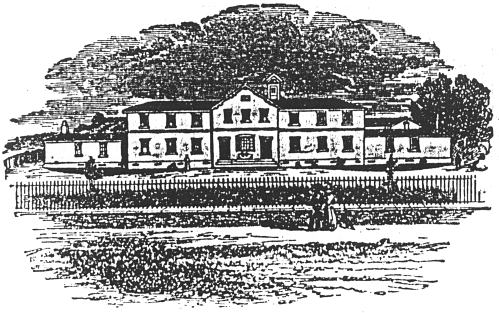Gainsborough, Lincolnshire
Up to 1834
A poorhouse was built in Gainsborough in 1730. It was built around a square, later known as Albert Square, closed off from Church Street by a high wall. The Master and Matron lived in the front block of the building which also contained the dining-room and kitchen.
A parliamentary report of 1777 recorded parish workhouses in operation at Gainsborough for up to 70 inmates, and at East Stockwith for up to 40.
After 1834
Gainsborough Poor Law Union was officially formed on 19th January 1837. Its operation was overseen by an elected Board of Guardians, 47 in number, representing its 45 constituent parishes as listed below (figures in brackets indicate numbers of Guardians if more than one):
County of Lincoln:
Blyborough, Blyton-cum-Warton [Wharton], Brampton, Coates, Corringham, Fenton, Fillingham, Gainsborough (3), Gate Burton, Glentworth, Grayingham, Hardwick, Harpswell, Haxey, Heapham, Hemswell, Kettlethorpe, Kexby, Knaith, Laughton, Lea, Marton, Morton, Newton-on-Trent, Northorpe, Scotter, Scotton with East Ferry, Southorpe, Springthorpe, East Stockwith, Stow, Sturton and Barnsby, Torksey, Upton, Walkerith, Wildsworth, Willingham, Willoughton.
County of Nottingham:
Beckingham, Bole, Misterton, Saundby, Walkeringham, West Burton, West Stockwith.
Later Additions: Greenhill and Redhill (from 1861), Owston (from c.1838), Owston Ferry (from 1912), Thonock (from 1895), West Butterwick (from c.1838).
The population falling within the Union at the 1831 census had been 19,675 with parishes ranging in size from Southorpe (population 36) to Gainsborough itself (6,658). The average annual poor-rate expenditure for the period 1834-36 had been £6,721 or 6s.10d. per head.
A new Gainsborough Union workhouse was built 1837 on Lea Road at the south-east of Gainsborough. The Poor Law Commissioners authorized an expenditure of £3,500 for construction of the building which intended to accommodate 200 inmates. It was designed by George Wilkinson who was the architect of many other workhouse buildings, although Gainsborough was the only one in Lincolnshire. His design was based on the model "square" plan published by the Commissioners in 1835. The workhouse location and layout can be seen on the 1887 map below.

Gainsborough workhouse site, 1887.
The chapel, at the south of the workhouse, was erected in 1861 at a cost of £800. It contained a stained-glass window in memory of Thomas Oldham, Clerk to the Guardians from 1837 to 1861.

Gainsborough workhouse c.1843
After 1930, the workhouse became a Public Assistance Institution and later a residential home under the name of Oakdene.
The former workhouse buildings have now been demolished.
North Marsh Road Children's Home
The Gainsborough Union operated a children's home known as 'Chesleigh' at 13-15 North Marsh Road. It could house up to 29 children. The property is now in private residential use.
Staff
Inmates
Records
Note: many repositories impose a closure period of up to 100 years for records identifying individuals. Before travelling a long distance, always check that the records you want to consult will be available.
- Lincolnshire Archives, St. Rumbold Street, Lincoln LN2 5AB. Holdings include Guardians' minute books (1843-54, 1859-1930); Admissions and discharges (1889-1935, with gaps); Births (1914-22); Baptisms (1888-1961); Deaths (1816-1935); Creed register (1879-1935, with gaps); etc.
Bibliography
- The Book of Gainsborough by Ian Beckwith.
Links
- None.
Unless otherwise indicated, this page () is copyright Peter Higginbotham. Contents may not be reproduced without permission.


